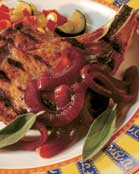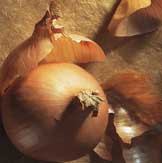
The blend of olive oil, white wine, lemon juice, herbs and other seasonings favored by Chef Todd Downs fits the standard definition of a marinade. If it also sounds like vinaigrette-with three parts oil to one part acid-well, it is. But the mixture performs several chores when applied as a marinade. Penetrating only about 1/8 inch into the meat, the marinade flavors and crusts the surface when it is seared.

Searing Impact
Acidic ingredients not only help tenderize and “relax” the surface, but also add a pleasant sharpness. “I cook the alcohol out of wine first so it doesn't overwhelm the other flavors,” says Downs, executive chef of the Park Avenue Cafe, Doubletree Guest Suites, Chicago.Oil also has a job to do. “Oil coats the pork so that oxygen won't discolor it—and then it helps brown it,” says Stephen Simmons, executive chef of Stratford, an upscale senior residence center in San Rafael, Calif.
Chef Al Hynes of Freeport, Maine's Harraseeket Inn uses ketchup, orange juice, teriyaki sauce, sherry, granulated garlic and any of the 20-plus herbs in the inn's summer garden (oregano, chervil and basil are favorites). Sweetness in the ketchup and teriyaki caramelize the crust even though the pork loin is slow-cooked at 300° F.
Proprietor Chef Robert Merrifield of The Polo Grill in Tulsa, Okla., starts a favorite marinade with soy sauce, ginger, lime zest and juice, and white pepper. Adding banana ketchup and cola adds a distinctive punch to his roasted pork tenderloin.
“If you went to the Yucatan, barbecued pork is the number one thing you'd want to eat,” says Chef Miguel Ravago of Fonda San Miguel, Austin, Texas. Ravago takes boneless pork shoulder, scores and portions it to maximize surface area, then brushes it with a spicy paste, wraps it in softened banana leaves and marinates. The braised, fork-tender meat is shredded and wrapped in corn tortillas with an accompaniment of onions pinkened by beets in the pickling solution.
In Chef David Waltuck's kitchen, pork ribs are marinated in soy sauce, balsamic vinegar, sesame oil and sugar to become a sublime dish that is economical enough for staff meals. The ribs are deep fried, then simmered in chicken stock flavored with more soy sauce, fermented Chinese black beans and hot red pepper flakes.
The technique for escabeche, a classic preparation that calls for marinating fish after it's cooked, can be adapted to pork. Cookbook author Mark Bittman says bathing hot meat in a hot marinade results in better flavor absorption. Because the meat is cooked, Bittman's marinade—which calls for red wine vinegar, red wine, thyme, onion, garlic and sugar—can do double duty as a sauce.

Brine of the Times
Like the earliest brine—probably seawater—today's brines invariably begin with water and salt. To this, Simmons adds garlic, molasses or brown sugar, and perhaps toasted star anise or chiles. He lets the flavors blend at room temperature for a few hours before immersing pork loin or shoulder in the liquid for three hours. “The brine tenderizes the interior,” he says.Food science writer Robert Wolke explains why brines penetrate when most marinades don't: “When a [meat muscle] cell is bathed in a brine that has more free water molecules per cubic inch than it has, Nature tries to even things up by forcing free water molecules through the membrane. The result is a transfer of water from the brine into the cells, making a juicier piece of meat” (“What Einstein Told His Cook,” W.W. Norton, 2002). Because of a similar imbalance, salt ions dissolved in the brine also migrate to the meat cells, increasing their ability to hold water.
Downs, dubbed “the brine king” by chef friends, has been brining for 10 of the 24 years he's spent in a foodservice kitchen. He relies on “flavor brines” with as little as one part salt for 32 parts water, compared to the 1:2 proportions of traditional pickling brines.
While keeping salt to a minimum, Downs is lavish in his use of flavoring agents. Brine for pork ribs is seasoned with mustard seed, allspice and peppercorns, for instance, while tequila, cumin and chiles define a Latino-style brine. Downs once thrilled customers with his brined rendition of a pork tenderloin sandwich, an Indiana specialty. He pounded Canadian back very thin and soaked in a brine flavored with mustard, rosemary and garlic for two hours before breading and frying it.
Many chefs brine, then marinate to get the benefits of each technique. “With customers more quality conscious, chefs are always looking for ways to improve,” Downs says. “Brines and marinades help us deliver more flavor to the menu.”
Basic Flavor Brine
Todd Downs, executive chef, Park Ave. Cafe, Doubletree Guest Suites, ChicagoYield: about 2 qt
2 qt Water
1 C Sugar
2 TBS Kosher salt
12 each Fresh thyme sprigs
6 each Fresh rosemary sprigs
2 TBS Black peppercorns,crushedm
3 each Bay leaves, broken
6 each Garlic cloves, smashed
3 each Shallots, thinly sliced
1. Combine all ingredients in a non-reactive stock pot. Bring to a boil. Reduce heat and simmer for 2 minutes.
2. Cool mixture to room temperature. Strain.
3. Brine desired cuts, covered, refrigerated. Brining times: Pork loin, 2 days; pork tenderloin, 12 hours or overnight; pork scallops, 2 hours; turkey (whole, 12-lb bird), 3 days.
Notes: Substitute other liquids for all or part of the water, such as apple cider, beer, bourbon. Other sweeteners, such as maple syrup or brown sugar, can be used. Additional flavorings, such as chiles, ginger and lemongrass, also work well.